Mistletoe Cactus (Rhipsalis baccifera) is the star of our show today. As a tropical cactus, it strays from the typical prickly characters you might imagine when hearing the word “cactus.”
Instead, this plant boasts slender, leafless, succulent stems that bring a unique visual appeal to your indoor jungle.
Besides its whimsical appearance, the Mistletoe Cactus is incredibly easy to care for, making it an ideal choice for newbie and expert gardeners alike!
Here, we’ll cover everything you need to know about Rhipsalis Mistletoe Cactus care to help it thrive in your home.
Table of Contents
Mistletoe Cactus Plant Care Guide
History, Habitat, and Characteristics

Mistletoe Cactus (Rhipsalis baccifera) is a cactus, but not your usual prickly kind.
Originally from the Caribbean, as well as Central and South America, this unique cactus has a penchant for tropical climates and hanging out in trees — quite the opposite of its desert-dwelling relatives. The Rhipsalis Mistletoe Cactus is an epiphyte, meaning it isn’t usually rooted into the ground and can thrive on various surfaces like tree branches.
This charming plant, also called the Spaghetti Cactus, sports large, trailing stems with rounded leaves. It mostly lacks sharp parts, which means that Rhipsalis Mistletoe Cactus is an attractive and safe choice for your indoor garden. It’s worth noting that some varieties might have small spines, though, so best to know your new green friend before getting too cozy.
Where did that merry name come from? Well, after mistletoe cactus plants bloom with creamy or white flowers, they puts out little seed pods on its stems that resemble the white berries found on mistletoe. It’s also known as Christmas Cactus for this reason (not to be confused with another cactus that goes by the same name, Schlumbergera × buckleyi!).
Fun fact: Mistletoe Cactus is the only cactus discovered naturally growing outside the Americas, also being found (surprisingly!) in tropical Africa and Sri Lanka.
Mistletoe Cactus Varieties
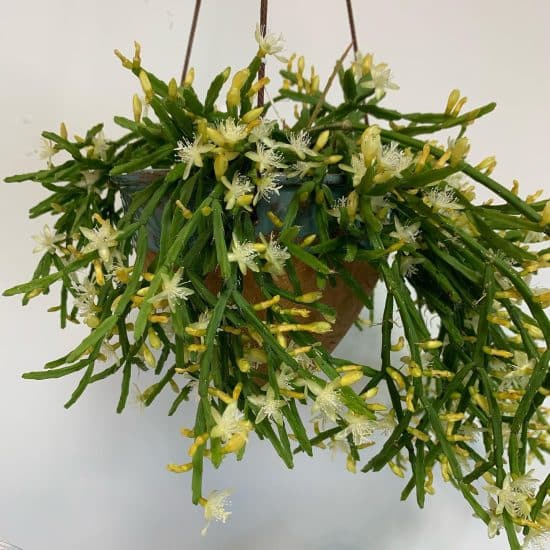
There are dozens of mistletoe cactus plants in the Rhipsalis genus, but they can be divided into one of three stem types: angular, flattened, and terete (cylindrical).
Here are some of our favorite Rhipsalis varieties:
- Trailing Mistletoe Cactus (Rhipsalis capilliformis) – Also known as “Old-Man’s Beard,” it has small, thin green stems that mound and trail, resembling a beard.
- Drunkard’s Dream Mistletoe Cactus (Rhipsalis salicornioides) – Young growth is fuzzy and soft, but when it gets older, stems ditch the fuzz and get cylindrical, attaching like joints.
- Hairy Stemmed Rhipsalis (Rhipsalis pilocarpa) – Also called pilose mistletoe cactus, this plant has stems covered in soft white hair and small flowers (white).
- Coral Cactus (Rhipsalis cereuscula) – Also called “rice cactus,” this shrub-like cactus featuring bright green rice-shaped joints that connect to form long, thin stems.
- Chain Cactus (Rhipsalis paradoxa) – Features flat green stems with serrated edges that look like the rings of a chain. Produces fancy white flowers resembling bells. Great for a hanging basket.
- Rhipsalis elliptica – Has many branches sporting round green, scalloped stems that turn copper-brown in strong sun.
- Rhipsalis clavata – A super elegant variety with light green stems that look like dangling pendants, topped by bell-shaped white flowers.
- Red Coral Rhipsalis (Rhipsalis ramulosa or Pseudorhipsalis ramulosa) – Stunning flat purple-red stems that turn an intense red-violet in strong sun.
There are more Rhipsalis plants, but you get the gist. Now let’s get into light requirements for all types of Mistletoe Cactus (note that any varieties with color usually require more sun to stay vivid).
Light

Mistletoe Cactus prefers shadier spots than many other cacti, given that it naturally grows in the understory of tropical forests.
This unique jungle cactus appreciates dappled indirect light, which means it can benefit from a bit of morning sun and afternoon shade, rather than being exposed to direct sunlight all day long. Mimicking its natural environment will help this tropical cactus to truly flourish indoors.
Not enough light: If your Mistletoe Cactus isn’t basking in adequate light, you may notice it growing slowly, with long, spindly stems as it reaches out toward the sun. It may also appear somewhat dull and lack its usual vibrancy.
Too much light: Excessive light exposure can also harm your Rhipsalis plant. Watch out for sunburned leaves, which may turn brown and crispy, or even start to wither and drop off.
Water
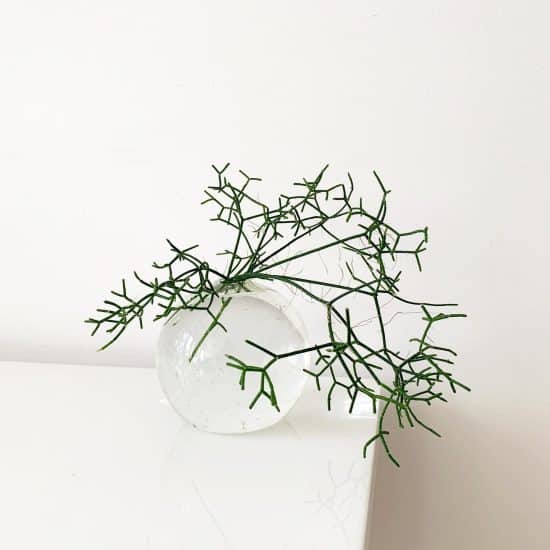
Your Mistletoe Cactus is a big fan of regular watering (especially during its growing season), but it’s crucial not to overdo it. It does like the soil to be on the moister side of things, but you don’t want to end up with soggy soil or, worse, your plant sitting in a pool of water. When the soil feels dry to the touch, that’s your cue to give it a drink.
If your Mistletoe Cactus is not receiving enough water, you might notice its stems becoming shriveled, limp, and pale. Your plant might even start drooping. To turn things around, you’ll want to water your cactus more often — just remember to let the soil dry out a bit between waterings.
Too much water can lead to sogginess, yellowing leaves, or even root rot in Rhipsalis plants. In more severe cases, stem segments might turn mushy and discolored. If you notice these signs, ease off on your watering routine to let the soil dry out a little more between waterings. Any mushy segments should be removed with sterilized scissors or shears to prevent the spread of disease.
Temperature and Humidity
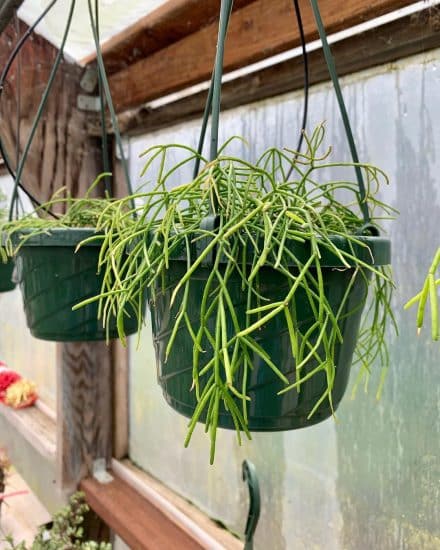
Keep your Mistletoe Cactus in a comfortable temperature range of 65-80°F (18-27°C). Avoid exposing it to extreme heat or cold, as this can cause damage to the foliage and stunt its growth. Keep your plant away from drafty windows and doors during winter months and be cautious of air conditioning vents in the summer.
Ideally, you should aim for humidity levels between 40-60%. If your cactus is experiencing too much humidity, you might notice yellowing or mushy leaves. In contrast, if the humidity is too low, Rhipsalis plants may develop crispy ends, and the leaves may turn brown or dry.
Temperature and humidity care tips:
- Keep your Mistletoe Cactus plant in temperatures between 65-80°F (18-27°C) and away from sources of extreme temperature changes.
- Aim for humidity levels between 40-60% for optimal growth and health.
- Increase humidity by using a humidifier, a pebble tray, or by placing your Mistletoe Cactus near other plants so they can share the benefits of collective transpiration.
Soil and Planting
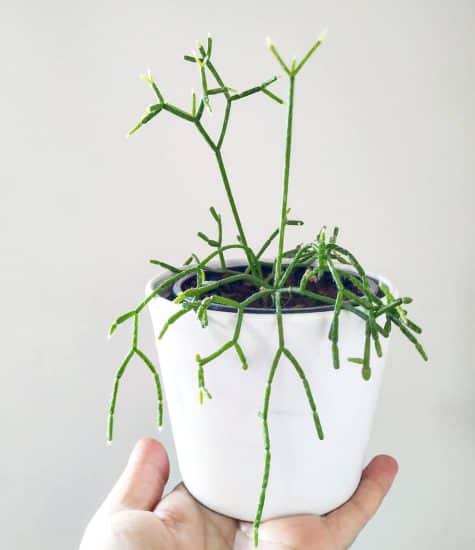
Although your Mistletoe Cactus can grow without soil, potting it will prevent the roots from drying out too much and also provide a steady supply of nutrients.
Using a well-draining soil for your Mistletoe Cactus is key. A pre-made cactus mix would work well, or you can make your own regular potting soil mixture by using a standard potting mix with orchid bark and perlite, pumice, or LECA added in to promote drainage.
Slow growth, yellowing leaves, and a generally unhealthy appearance may be signs of inadequate drainage. In this case, you may need to replant your Mistletoe Cactus in fresh, well-draining soil, or repot your plant in a container that offers better drainage.
Terracotta pots with holes in the sides make great containers for this epiphytic cactus, as they promote good air circulation around the roots. Terracotta pots also help keep overwatering at bay by letting excess moisture escape (we’re all about well-drained soil here!).
Fertilizer
To provide extra nutrients for your Mistletoe Cactus during the growing season, try sprinkling worm castings around its base or use a water-soluble all-purpose fertilizer.
Be careful of over-fertilizing, however. Using too much fertilizer can lead to symptoms such as leaf burn and wilting. In this case, flush the soil through with water to remove excess fertilizer salts, and then reduce your fertilizer application in the future.
Pruning
Mistletoe Cacti are typically low-maintenance plants in the cactus family, but occasional pruning can help maintain a tidy appearance and encourage new growth. Use clean, sterilized shears or scissors to trim back any dead or damaged stems. This will allow your plant to focus its energy on producing new growth, promoting an overall healthier and more attractive plant.
Propagation
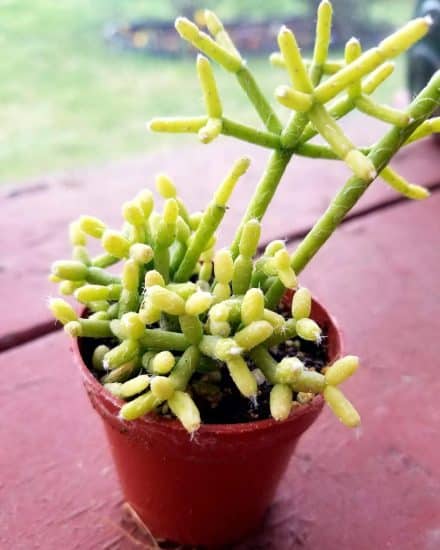
Propagate new plants for yourself or share the love with friends by following these easy-peasy steps.
Propagate Mistletoe Cactus via stem cuttings:
- Pick a winner: Start by seeking out a healthy stem on your Mistletoe Cactus. Make sure it’s got plenty of lush growth and no signs of pests or disease.
- Snip the stem: Grab your sterilized gardening shears and make a clean cut at a node between two stem segments, ensuring your cutting has a few segments of growth on it.
- Propagate it in water: Pop your cutting into a small container filled with filtered water. Change the water every 2-3 days and place your container in a spot with bright, indirect light.
- Keep an eye out for root growth: In a few weeks, your new plant should start sprouting new roots. When they’re about 2 inches long, it’s time to plant your cutting.
- Make the move: Fill a suitable pot with well-draining soil and tuck your cutting into it, taking care with its delicate roots. Give it a good watering and keep the soil nice and moist (but not drenched) for the first few weeks to help your cutting settle in.
Common Issues
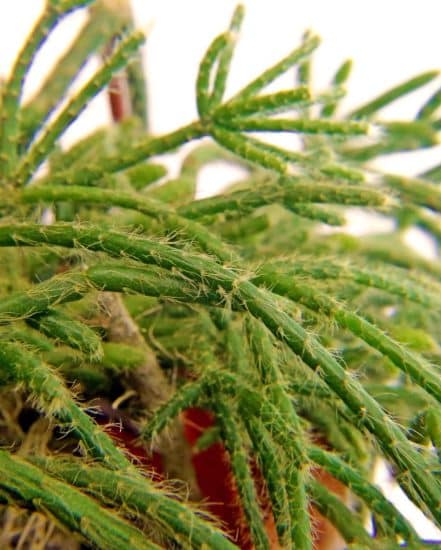
Rhipsalis Mistletoe Cactus care is usually smooth sailing, but sometimes brown stems can come into play.
Browning Stems
If you notice stem sections turning brown, it could mean a fungal infection, damage by pests, or even overwatering (especially if the stems are also mushy).
To tackle this problem, start by trimming the stems below the brown sections with sterilized pruning shears or scissors. After you’ve removed the brown part, any remaining sections that are healthy and green can be salvaged by propagating them as stem cuttings.
If the issue turns out to overwatering, let the soil dry out and adjust your watering schedule. But if you’re dealing with a fungal infection or pests, you’ll want to grab a suitable fungicide or insecticide for targeted treatment.
Pests and Diseases
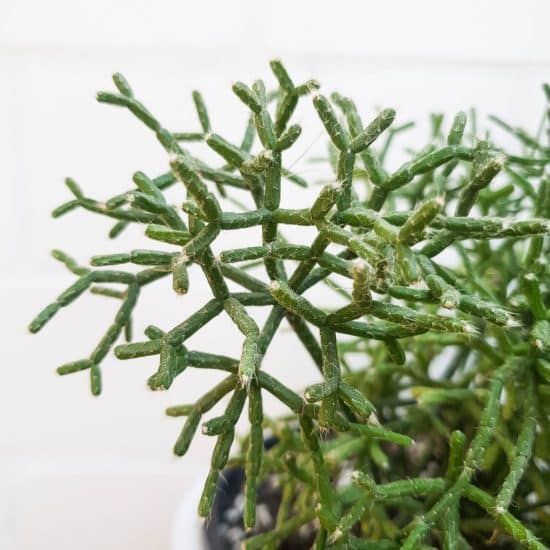
Mealybugs
If you notice cotton-like bits on the leaves and stems of your Mistletoe Cactus, you’ve got mealybugs on your hands.
Here’s how to evict these common pests from your plant:
- Start by isolating your Mistletoe Cactus from any other plants to keep the mealybugs from spreading. Then, pluck off those pesky mealybugs with your fingers or by spray them off with water.
- For larger infections or more stubborn cases, bring out the big guns and spray your plant with a mixture of dish soap and water or neem oil. Make sure you get every nook and cranny because these bugs are experts at hiding.
- Prevention is key! Keep an eye on your Mistletoe Cactus in the future and address any new mealybug infections quickly to keep them from spreading.
Root Rot
Soggy soil from overwatering or poor drainage can lead to root rot. Symptoms include wilting and yellowing stems, and a moldy smell coming from the pot. If you suspect root rot, take the plant out of the pot and check for mushy, slimy, and brown or black roots.
To save an infected Mistletoe Cactus, carefully snip away the rotten roots (just make sure to sterilize your cutting tool before and after use!). Then, repot your plant with fresh soil using a potting mix that has adequate drainage.
To keep root rot from coming back, always check the moisture level of the soil before watering, and never let your Mistletoe Cactus sit in standing water.
Conclusion

That’s a wrap for our Rhipsalis Mistletoe Cactus care guide!
We hope this guide has provided you with everything you need to care for your Mistletoe Cactus, so that this unique tropical houseplant brings charm and character to your indoor oasis for years to come.
Rhipsalis Mistletoe Cactus care summary:
- Provide bright morning sunlight, but avoid direct sunlight throughout the day. This replicates the dappled light conditions this cactus normally enjoys in its natural forest understory habitat.
- Ensure proper watering by keeping the soil moist, but not soggy, and adjust your watering frequency based on the plant’s environment.
- Create a comfortable indoor environment with temperatures between 65-80°F (18-27°C), and adequate humidity levels between 40-60%.
- Use a soil mixture that drains well (one that includes added orchid bark and perlite, pumice, or LECA) to promote optimal growth and root health.
- Occasional pruning and fertilizing can keep your Rhipsalis Mistletoe Cactus looking its best, while monitoring for and quickly tackling pests and diseases will ensure a healthy and thriving plant.
- If this guide has been helpful, feel free to share it with fellow plant lovers. If you have any additional questions or require further assistance, please don’t hesitate to get in touch with us.
- Take care, and happy planting!
FAQ
Is Mistletoe Cactus prickly?
Mistletoe Cactus is a friendly and touchable plant that’s safe to have around your home, even if you have curious kids or pets. Of course, it’s always best to keep an eye on little ones and furry friends, but you can breathe a sigh of relief knowing that this unique cactus from the tropics isn’t armed with prickly spines like most desert cacti.
Are epiphytic cacti common?
Epiphytic cacti, like our intriguing Mistletoe Cactus, are actually quite common in their native habitats. The unique trait that makes a cactus epiphytic is its ability to grow on other surfaces, like tree branches or rocks, instead of needing to be rooted into soil to survive.
This special lifestyle allows epiphytic cacti to absorb moisture from the surrounding air, and nutrients from the debris that collects around their roots. Pretty neat, huh? In their natural environments, these adaptable plants can be found happily hanging out on their chosen perches.


